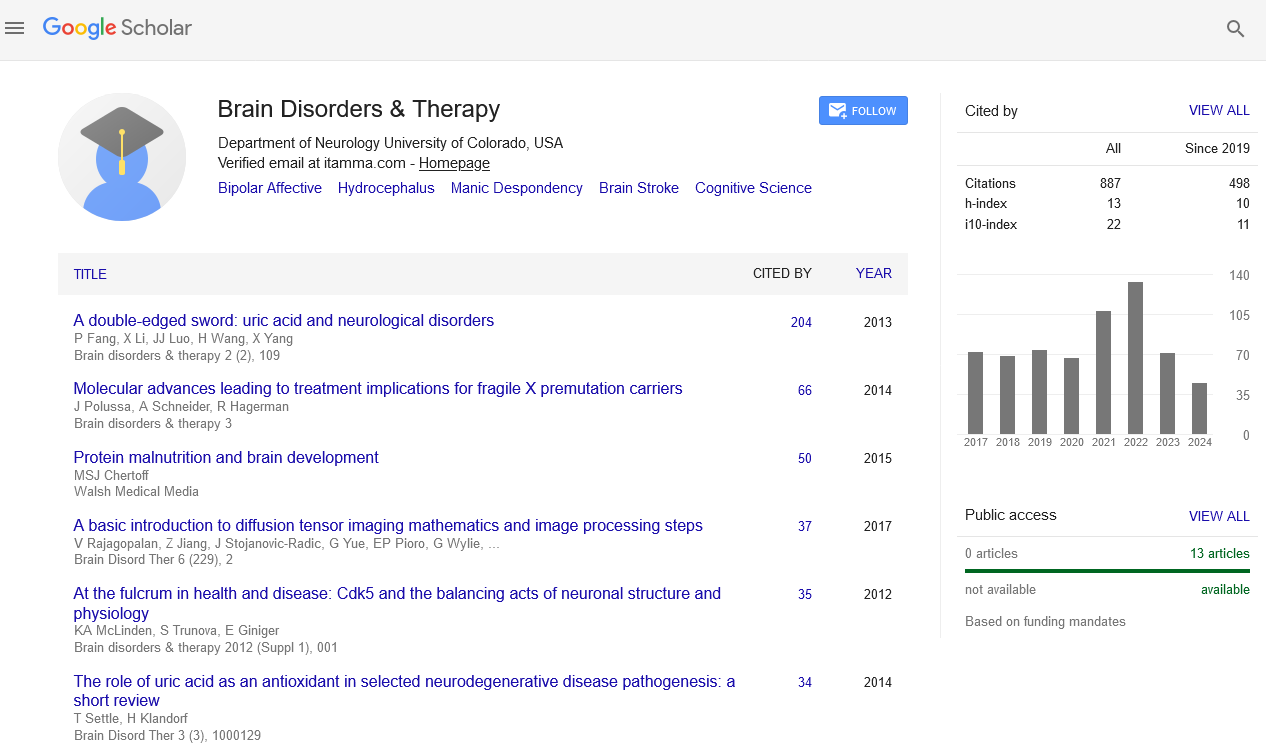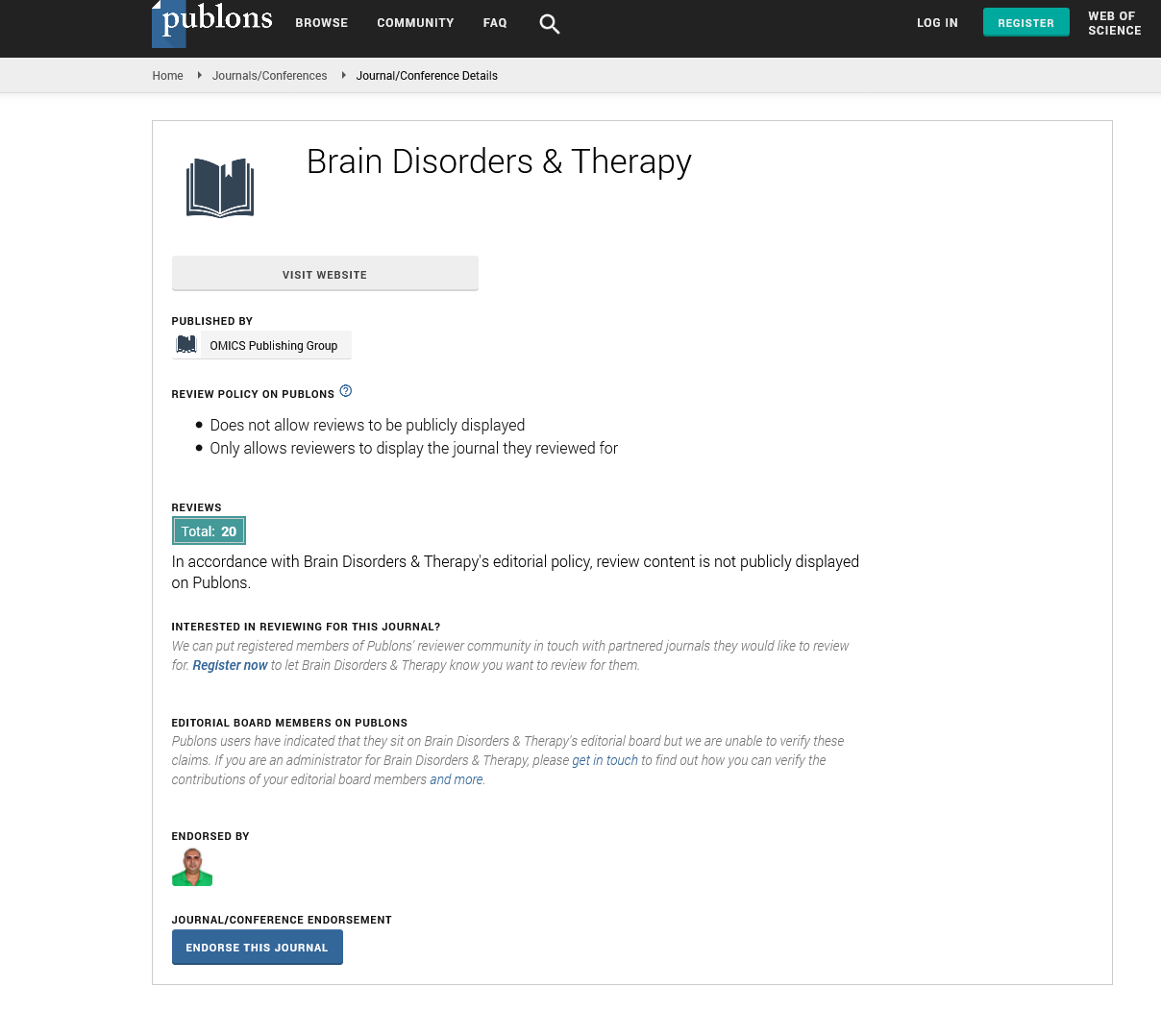Indexed In
- Open J Gate
- Genamics JournalSeek
- JournalTOCs
- RefSeek
- Hamdard University
- EBSCO A-Z
- OCLC- WorldCat
- Publons
- Geneva Foundation for Medical Education and Research
Useful Links
Share This Page
Journal Flyer

Open Access Journals
- Agri and Aquaculture
- Biochemistry
- Bioinformatics & Systems Biology
- Business & Management
- Chemistry
- Clinical Sciences
- Engineering
- Food & Nutrition
- General Science
- Genetics & Molecular Biology
- Immunology & Microbiology
- Medical Sciences
- Neuroscience & Psychology
- Nursing & Health Care
- Pharmaceutical Sciences
Commentary - (2024) Volume 13, Issue 3
Neuroimmune Interactions in Ferroptosis: A New Approach to Brain Health
Ye Zhang*Received: 26-Aug-2024, Manuscript No. BDT-24-27095; Editor assigned: 29-Aug-2024, Pre QC No. BDT-24-27095(PQ); Reviewed: 12-Sep-2024, QC No. BDT-24-27095; Revised: 19-Sep-2024, Manuscript No. BDT-24-27095(R); Published: 26-Sep-2024, DOI: 10.35248/2168-975X.24.13.269
Description
Ferroptosis, a recently discovered form of regulated cell death, has emerged as a potential target for the development of novel therapeutics in neuroimmune and neurodegenerative disorders. Distinguished from apoptosis, necrosis and other forms of cell death, ferroptosis is driven by iron-dependent lipid peroxidation, which leads to the accumulation of Reactive Oxygen Species (ROS) and subsequent cellular damage. This unique pathway has been implicated in a range of neurodegenerative diseases, including Alzheimer’s disease, Parkinson’s disease, Amyotrophic Lateral Sclerosis (ALS) and Multiple Sclerosis (MS).
Ferroptosis was first identified in 2012 and has since gained attention due to its association with oxidative stress and its contribution to various disease mechanisms. In the brain, which is rich in lipids and consumes high levels of oxygen, cells are particularly vulnerable to oxidative damage. Iron, a central player in ferroptosis, facilitates the production of ROS through Fenton reactions, which promote lipid peroxidation. When the cellular defense mechanisms, particularly antioxidant systems, fail to neutralize these ROS, ferroptosis is triggered, leading to neuronal damage.
In neurodegenerative disorders, oxidative stress and inflammation are long-standing contributors to disease progression. The buildup of oxidative damage, coupled with iron accumulation in brain regions like the hippocampus and substantia nigra, has been linked to diseases such as Alzheimer’s and Parkinson’s. In Alzheimer’s disease, iron deposits often colocalize with amyloid plaques, contributing to oxidative stress and cellular dysfunction. Similarly, in Parkinson’s disease, the death of dopaminergic neurons in the substantia nigra is exacerbated by mitochondrial dysfunction and the accumulation of iron. These processes prime neurons for ferroptosis, accelerating the loss of neuronal function.
Multiple Sclerosis (MS) and Amyotrophic Lateral Sclerosis (ALS) also involve mechanisms where ferroptosis could play a essential role. MS is an autoimmune disorder that results in the degradation of the myelin sheath surrounding nerve fibers, leading to neuroinflammation and oxidative stress. Lipid peroxidation, a sign of ferroptosis, is known to contribute to the demyelination process. ALS, which primarily affects motor neurons, also exhibits high levels of oxidative stress and mitochondrial damage, creating an environment conducive to ferroptosis. The idea that preventing ferroptosis could mitigate some of the neurodegenerative effects in these diseases is gaining traction.
At the core of the ferroptosis pathway is Glutathione Peroxidase 4 (GPX4), an enzyme responsible for reducing lipid peroxides and protecting cells from oxidative stress. When GPX4 is inhibited, lipid peroxides accumulate, leading to ferroptotic cell death. Neurodegenerative disorders often exhibit reduced GPX4 activity, making neurons more susceptible to oxidative damage. This suggests that restoring or mimicking GPX4 function could be a potential therapeutic strategy. Small molecules that either increase GPX4 activity or prevent its inhibition are currently being investigated as a means to prevent ferroptosis and protect neurons from the oxidative stress that leads to cell death.
Another critical player in ferroptosis regulation is system Xc-, a cystine/glutamate antiporter that imports cystine, a precursor for glutathione synthesis. Glutathione, one of the body’s most powerful antioxidants, is essential for maintaining the redox balance and preventing lipid peroxidation. Inhibition of system Xc- leads to a depletion of glutathione, increasing the susceptibility of cells to ferroptosis. In neurodegenerative diseases, the dysfunction of system Xc- has been observed, contributing to the loss of cellular antioxidant defenses. Enhancing system Xc- activity or boosting glutathione levels could offer a therapeutic benefit by reducing oxidative damage and preventing ferroptosis.
Conclusion
Focusing on ferroptosis represents a novel and exciting therapeutic approach for neuroimmune and neurodegenerative disorders. By addressing the underlying mechanisms of oxidative stress, lipid peroxidation and iron dysregulation, researchers are developing new strategies to prevent neuronal death and slow disease progression. Although much work remains to translate these findings into clinical therapies, the potential for ferroptosis inhibitors to provide neuroprotection and improve patient outcomes is significant. As the field of ferroptosis research advances, it may establish groundwork for new treatments that address the root causes of neurodegenerative diseases rather than just managing their symptoms.
Citation: Zhang Y (2024). Neuroimmune Interactions in Ferroptosis: A New Approach to Brain Health. Brain Disord Ther. 13:269.
Copyright: © 2024 Zhang Y. This is an open-access article distributed under the terms of the Creative Commons Attribution License, which permits unrestricted use, distribution, and reproduction in any medium, provided the original author and source are credited.


